What kind of feeding is needed for orchids?
Orchid considered one of the most beautiful and capricious houseplants. Many are afraid to grow this beautiful flower at home, because they are afraid of difficulties in care. But the rules for caring for an orchid are not as complicated as it might seem at first glance. One of the most important elements of care is the correct feeding, on which both the flowering and the growth of the orchid depend.
Content:
- Orchid: description and the best varieties for the home
- What is the best way to feed orchids?
- Rules and timing of feeding
- Errors and consequences of improper feeding
Orchid: description and the best varieties for the home
Orchid represents one of the most numerous plant families. It has a huge number of species and varieties. Orchids are epiphytic plants. In natural conditions, they grow on the bark of trees.
Orchids grow and bloom well at home, but proper care is needed: lighting, watering, moisture, special feeding for orchids.
Many people dream of growing an orchid at home, since it is considered a symbol of beauty and perfection all over the world. The ability to grow different varieties of orchids is considered the ultimate gardening skill. The orchid has 2 bulbous roots, due to which the flower got its name (orchis - testicle).
The modern classification of orchids has 5 subfamilies, each of which has many species and varieties. For the home, it is best to choose more hardy and unpretentious orchid varieties:
- Cambria. This is a beautiful hybrid orchid species that does not occur naturally. Cambria flowers have various shapes and colors: white, purple, pinkish, with spots and stains. The flowers are quite large and need to be maintained. These flowers love light, but cannot tolerate direct sunlight.
- Cymbidium. Large orchids with a wide range of colors. Up to 20 flowers can be located on an erect stem. This is one of the more hardy varieties, so it is good for beginners. This orchid is especially beloved in China, where images of cymbidium can be found everywhere.
- Miltonia. This orchid is very beautiful but rather difficult to care for. Only professional flower growers can grow blooming miltonia. The flowers are very large and bright. One of the popular varieties of miltonia is a bright, purple-pink flower that resembles large pansies.
- Odontoglossum. Bright, exotic, but capricious flowers. The flowers have specks or stripes. They love coolness, grow in the jungle in nature.
What is the best way to feed orchids?
Orchids of all kinds need feeding... The soil is quickly depleted, and to maintain flowering it needs to be enriched with nutrients. To feed your orchid, you can buy orchid fertilizer from the store. If for some reason it is impossible to find such fertilizer, you can buy a universal complex mineral fertilizerbut it is important to read its composition and proportions of minerals. An orchid may react poorly to some fertilizer components.
Top dressing can be root or foliar (spraying).
Fertilizer for an orchid should contain the following elements:
- Nitrogen. Nitrogen is essential for the normal growth of the plant, but in the case of orchids, do not overdo it. It is better to underfeed the flower with nitrogen than to overfeed.Nitrogen is important for the development of stems, foliage, green mass, but it will not affect the flowering itself much, but an excess of nitrogen damages the flower.
- Potassium. Potassium allows plants to use water more economically, is responsible for the delivery of nutrients to all parts of the plant. Potassium is essential for flowering, if there is enough, the orchid will bloom.
- Phosphorus. Phosphorus is also important for flower formation, so there should be enough of it in the fertilizer. Phosphorus is responsible for energy processes in plant cells. Lack of phosphorus is primarily reflected in the color of the leaves, which begin to darken and coarse.
- Magnesium. Magnesium is necessary for photosynthesis, with a lack of it, the leaves turn pale. Magnesium should be included in mineral fertilizers, but, as a rule, in small quantities.
When buying a mineral fertilizer, you need to look at the label where the formula "nitrogen: phosphorus: potassium" is indicated. For example, if the formula indicates 5: 6: 7, then the fertilizer contains 5% nitrogen, 6% phosphorus and 7% potassium, such fertilizer will contribute to the flowering of the orchid.
Rules and timing of feeding
It is important not only to choose the right fertilizer, but also to apply it correctly and on time. It is undesirable to violate the rules for feeding the orchid, as this can lead to the cessation of flowering and the death of the flower:
- You need to start fertilizing an orchid not immediately after purchase, but after the end of the store bloom. During flowering, top dressing will not bring benefits, nutrients are needed when the plant is just gaining color. After the beginning of flowering, this process can no longer be influenced.
- If the orchids have faded, but immediately began to bloom again, you can start feeding without waiting for the end of flowering.
- Mineral fertilizers must be diluted with water, as they are quite concentrated. For orchids, the concentration should be much lower.
- The feeding process is necessarily accompanied by watering. Before starting feeding, the orchid is well watered so that the roots are saturated with moisture.
- Top dressing is carried out several times a year, but not all year round. Excess minerals can harm the plant. The least dangerous are only special fertilizers for orchids, where the proportions of minerals are selected specifically for this flower.
- For orchids, only liquid fertilizers are suitable. The soil for the orchid is already quite dense and lumpy. Dry fertilizers cannot be evenly distributed over it, so it is better to give preference to water-soluble mineral dressings.
- In the case of orchids, lack of fertilizer is better than excess. The first feeding of a store flower should have a minimum concentration. We need to see how the flower will react.
- Fertilize the orchid as it grows. The flower itself makes it clear when to feed it. If new leaves appear from the point of growth, top dressing is needed. As soon as the leaves stop appearing, feeding stops.
Errors and consequences of improper feeding
Delicate orchid does not tolerate mistakes in care. Improper feeding can destroy the flower, so you need to remember the basic rules and carefully select the fertilizer.
Inexperienced gardeners most often make the following mistakes in feeding orchids:
- Fertilizing dry soil. As mentioned above, make mineral fertilizers only after good watering. Dry roots get burned from the mineral concentrate. It is very difficult to restore a damaged root, often the orchid dies.
- Overfeeding. When growing an orchid, the rule "the more the better" does not work. An excess of mineral fertilizers leads to a deterioration in growth and flowering, burns and drying of the flower.
- Incorrectly chosen feeding time. If you start actively fertilizing your orchid during the flowering period, it can shed flowers.
- Feeding sick plants. Fertilizer is not a cure for orchids. Top dressing will only help if the flower is sick from a lack of nutrients, but this is not a panacea. First you need to determine the cause of the plant disease.Feeding a sick flower can be harmful.
- Foliar dressing in sunny weather. Orchid leaves are very delicate, so all foliar dressings (spraying) are produced only in cloudy weather. The sun's rays, falling on wet leaves, burn the leaves.
- Incorrectly prepared solution. Dry mineral fertilizer should be added to the water, not vice versa, and allowed to stand without stirring. Incorrect preparation of the solution can lead to the fact that the fertilizer does not completely dissolve.
If the feeding procedure was carried out incorrectly, the orchid begins to hurt, flowering stops, the roots get burned, and the plant dies. If mistakes were noticed in time, you can leave the destructive process and restore the flower.
More information can be found in the video:



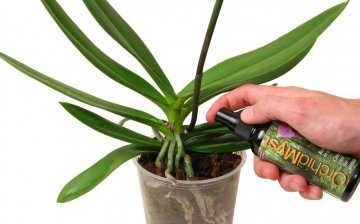
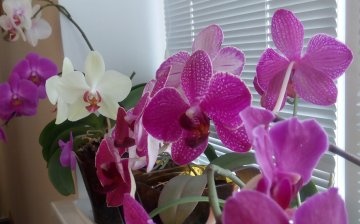
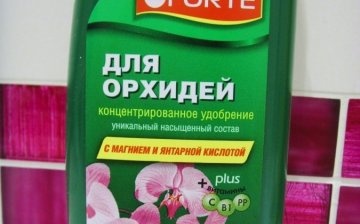
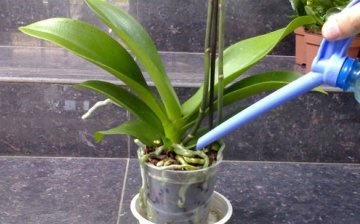






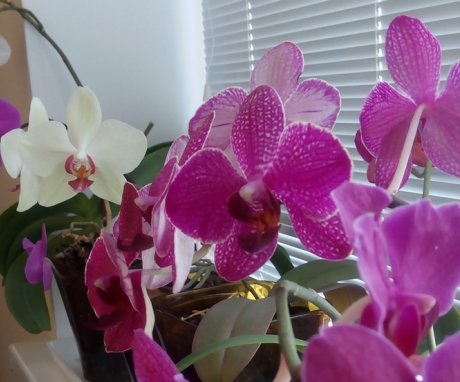

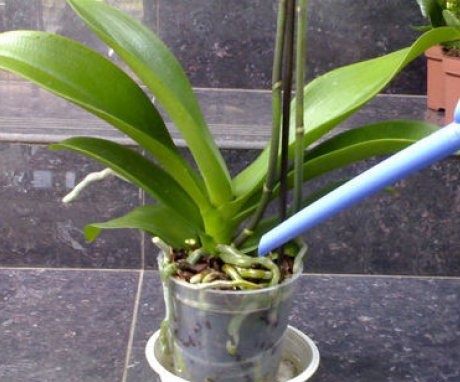

p.p1 {margin: 0.0px 0.0px 0.0px 0.0px; font: 12.0px Tahoma; color: # 383838; -webkit-text-stroke: # 383838; background-color: #ffffff}
span.s1 {font-kerning: none}
span.s2 {font-kerning: none; background-color: # ff5078}
I have my favorite white phalaenopsis orchids at home. This is the most unpretentious type of orchid, easy to care for. Once a week I "bathe" the flowers - pour water into the pot for 15 minutes and drain. And once every two weeks I add the usual universal fertilizer for orchids to the water. My beauties bloom for a long time, do not get sick.
Our phalaenopsis orchid grows in a pot filled with tree bark and we never fertilize the flower, periodically change the filler in the pot and water it. So far, the orchid has been growing well for several years now.